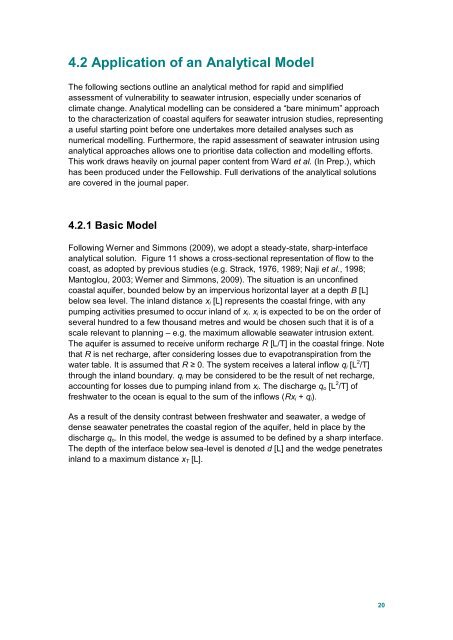Saltwater intrusion in Southern Eyre Peninsula, December 2009
Saltwater intrusion in Southern Eyre Peninsula, December 2009
Saltwater intrusion in Southern Eyre Peninsula, December 2009
Create successful ePaper yourself
Turn your PDF publications into a flip-book with our unique Google optimized e-Paper software.
4.2 Application of an Analytical Model<br />
The follow<strong>in</strong>g sections outl<strong>in</strong>e an analytical method for rapid and simplified<br />
assessment of vulnerability to seawater <strong><strong>in</strong>trusion</strong>, especially under scenarios of<br />
climate change. Analytical modell<strong>in</strong>g can be considered a “bare m<strong>in</strong>imum” approach<br />
to the characterization of coastal aquifers for seawater <strong><strong>in</strong>trusion</strong> studies, represent<strong>in</strong>g<br />
a useful start<strong>in</strong>g po<strong>in</strong>t before one undertakes more detailed analyses such as<br />
numerical modell<strong>in</strong>g. Furthermore, the rapid assessment of seawater <strong><strong>in</strong>trusion</strong> us<strong>in</strong>g<br />
analytical approaches allows one to prioritise data collection and modell<strong>in</strong>g efforts.<br />
This work draws heavily on journal paper content from Ward et al. (In Prep.), which<br />
has been produced under the Fellowship. Full derivations of the analytical solutions<br />
are covered <strong>in</strong> the journal paper.<br />
4.2.1 Basic Model<br />
Follow<strong>in</strong>g Werner and Simmons (<strong>2009</strong>), we adopt a steady-state, sharp-<strong>in</strong>terface<br />
analytical solution. Figure 11 shows a cross-sectional representation of flow to the<br />
coast, as adopted by previous studies (e.g. Strack, 1976, 1989; Naji et al., 1998;<br />
Mantoglou, 2003; Werner and Simmons, <strong>2009</strong>). The situation is an unconf<strong>in</strong>ed<br />
coastal aquifer, bounded below by an impervious horizontal layer at a depth B [L]<br />
below sea level. The <strong>in</strong>land distance x i [L] represents the coastal fr<strong>in</strong>ge, with any<br />
pump<strong>in</strong>g activities presumed to occur <strong>in</strong>land of x i . x i is expected to be on the order of<br />
several hundred to a few thousand metres and would be chosen such that it is of a<br />
scale relevant to plann<strong>in</strong>g – e.g. the maximum allowable seawater <strong><strong>in</strong>trusion</strong> extent.<br />
The aquifer is assumed to receive uniform recharge R [L/T] <strong>in</strong> the coastal fr<strong>in</strong>ge. Note<br />
that R is net recharge, after consider<strong>in</strong>g losses due to evapotranspiration from the<br />
water table. It is assumed that R ≥ 0. The system receives a lateral <strong>in</strong>flow q i [L 2 /T]<br />
through the <strong>in</strong>land boundary. q i may be considered to be the result of net recharge,<br />
account<strong>in</strong>g for losses due to pump<strong>in</strong>g <strong>in</strong>land from x i . The discharge q o [L 2 /T] of<br />
freshwater to the ocean is equal to the sum of the <strong>in</strong>flows (Rx i + q i ).<br />
As a result of the density contrast between freshwater and seawater, a wedge of<br />
dense seawater penetrates the coastal region of the aquifer, held <strong>in</strong> place by the<br />
discharge q o . In this model, the wedge is assumed to be def<strong>in</strong>ed by a sharp <strong>in</strong>terface.<br />
The depth of the <strong>in</strong>terface below sea-level is denoted d [L] and the wedge penetrates<br />
<strong>in</strong>land to a maximum distance x T [L].<br />
20

















